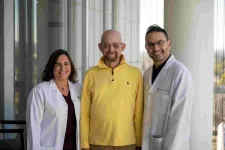(Press-News.org) Every year, around 50,000 people in the United States experience cardiogenic shock — a life-threatening condition, usually caused by a severe heart attack, in which the heart can’t pump enough blood for the body’s needs.
Many of these patients end up receiving help from a mechanical pump that can temporarily help the heart pump blood until it recovers enough to function on its own. However, in nearly half of these patients, the extra help leads to an imbalance between the left and right ventricles, which can pose danger to the patient.
In a new study, MIT researchers have discovered why that imbalance occurs, and identified factors that make it more likely. They also developed a test that doctors could use to determine whether this dysfunction will occur in a particular patient, which could give doctors more confidence when deciding whether to use these pumps, known as ventricular assist devices (VADs).
“As we improve the mechanistic understanding of how these technologies interact with the native physiology, we can improve device utility. And if we have more algorithms and metrics-based guidance, that will ease use for clinicians. This will both improve outcomes across these patients and increase use of these devices more broadly,” says Kimberly Lamberti, an MIT graduate student and the lead author of the study.
Elazer Edelman, the Edward J. Poitras Professor in Medical Engineering and Science and the director of MIT’s Institute for Medical Engineering and Science (IMES), is the senior author of the paper, which appears today in Science Translational Medicine. Steven Keller, an assistant professor of medicine at Johns Hopkins School of Medicine, is also an author of the paper.
Edelman notes that “the beauty of this study is that it uses pathophysiologic insight and advanced computational analyses to provide clinicians with straightforward guidelines as to how to deal with the exploding use of these valuable mechanical devices. We use these devices increasingly in our sickest patients and now have greater strategies as to how to optimize their utility.”
Imbalance in the heart
To treat patients who are experiencing cardiogenic shock, a percutaneous VAD can be inserted through the arteries until it is positioned across the aortic valve, where it helps to pump blood out of the left ventricle. The left ventricle is responsible for pumping blood to most of the organs of the body, while the right ventricle pumps blood to the lungs.
In most cases, the device may be removed after a week or so, once the heart is able to pump on its own. While effective for many patients, in some people the devices can disrupt the coordination and balance between the right and left ventricles, which contract and relax synchronously. Studies have found that this disruption occurs in up to 43 percent of patients who receive VADs.
“The left and right ventricles are highly coupled, so as the device disrupts flow through the system, that can unmask or induce right heart failure in many patients,” Lamberti says. “Across the field it’s well-known that this is a concern, but the mechanism that’s creating that is unclear, and there are limited metrics to predict which patients will experience it.”
In this study, the researchers wanted to figure out why this failure occurs, and come up with a way to help doctors predict whether it will happen for a given patient. If doctors knew that the right heart would also need support, they could implant another VAD that helps the right ventricle.
“What we were trying to do with this study was predict any issues earlier in the patient’s course, so that action can be taken before that extreme state of failure has been reached,” Lamberti says.
To do that, the researchers studied the devices in an animal model of heart failure. A VAD was implanted in the left ventricle of each animal, and the researchers analyzed several different metrics of heart function as the pumping speed of the device was increased and decreased.
The researchers found that the most important factor in how the right ventricle responded to VAD implantation was how well the pulmonary vascular system — the network of vessels that carries blood between the heart and lungs — adapted to changes in blood volume and flow induced by the VAD.
This system was best able to handle that extra flow if it could adjust its resistance (the slowing of steady blood flow through the vessels) and compliance (the slowing of large pulses of blood volume into the vessels).
“We found that in the healthy state, compliance and resistance could change pretty rapidly to accommodate the changes in volume due to the device. But with progressive disease, that ability to adapt becomes diminished,” Lamberti says.
A dynamic test
The researchers also showed that measuring this pulmonary vascular compliance and its adaptability could offer a way to predict how a patient will respond to left ventricle assistance. Using a dataset of eight patients who had received a left VAD, the researchers found that those measurements correlated with the right heart state, therefore predicting how well the patients adapted to the device, validating the findings from the animal study.
To do this test, doctors would need to implant the device as usual and then ramp up the speed while measuring the compliance of the pulmonary vascular system. The researchers determined a metric that can assess this compliance by using just the VAD itself and a pulmonary artery catheter that is commonly implanted in these patients.
“We created this way to dynamically test the system while simultaneously maintaining support of the heart,” Lamberti says. “Once the device is initiated, this quick test could be run, which would inform clinicians of whether the patient might need right heart support.”
The researchers now hope to expand these findings with additional animal studies and continue collaboration with manufacturers of these devices in the future, in hopes of running clinical studies to evaluate whether this test would provide information that would be valuable for doctors.
“Right now, there are few metrics being used to predict device tolerance. Device selection and decision-making is most often based on experiential evidence from the physicians at each institution. Having this understanding will hopefully allow physicians to determine which patients will be intolerant to device support and provide guidance for how to best treat each patient based on right heart state,” Lamberti says.
###
The research was funded by the National Heart, Lung and Blood Institute; the National Institute of General Medical Sciences; and Abiomed.
END
A new test could predict how heart attack patients will respond to mechanical pumps
Performing this test could help doctors prevent dysfunction that can occur when the right and left ventricles of the heart become imbalanced.
2024-02-14
ELSE PRESS RELEASES FROM THIS DATE:
Turning back the clock on photoaging skin
2024-02-14
Chronic exposure of human skin to ultraviolet light causes premature aging, or photoaging. As the skin undergoes photoaging, type I collagen bundles, which are found in the dermis beneath the top layer of the skin and provide strength and support to skin, become fragmented. This leads to wrinkles, fragility and loss of support and elasticity.
“The best way to prevent damage to type I collagen by sunlight is to wear sunscreen consistently, daily if possible and particularly when spending time outdoors,” said Frank Wang, MD, the William B. Taylor Endowed Professor of Clinical Dermatology at U-M Medical School.
Experts ...
City of Hope research featuring the successful treatment of the oldest patient to achieve remission for leukemia and HIV published in The New England Journal of Medicine (NEJM)
2024-02-14
LOS ANGELES — City of Hope®, one of the largest cancer research and treatment organizations in the United States, treated the oldest person to be cured of a blood cancer and then achieve remission for HIV after receiving a blood stem cell transplant from a donor with a rare genetic mutation. Research published in NEJM today demonstrates that older adults with blood cancers who receive reduced intensity chemotherapy before a stem cell transplant with donor cells that are resistant to HIV may be cured of HIV infection.
Paul Edmonds, 68, of Desert Springs, California, is the fifth person in the world to achieve remission for acute myelogenous leukemia ...
A lighthouse in the Gobi desert
2024-02-14
Los Angeles, CA (February 14, 2024) — A new study published in the journal PLOS ONE explores the weight great fossil sites have on our understanding of evolutionary relationships between fossil groups—the lagerstätten effect—and for the first time, quantified the power these sites have on our understanding of evolutionary history. Surprisingly, the authors discovered that the wind-swept sand deposits of the Late Cretaceous Gobi Desert’s extraordinarily diverse and well-preserved ...
Paradigm Shift: How a risk-based program is changing health care use and outcomes for children with high-risk asthma
2024-02-14
Le Bonheur’s risk-based innovation program Changing High-Risk Asthma in Memphis through Partnership (CHAMP) significantly decreased health care use related to asthma by targeting barriers to asthma care, according to research published in the Annals of Allergy, Asthma & Immunology. After one year of enrollment in the program, results analyzing 945 children included a 48% reduction in Emergency Department (ED) visits, 68% reduction in inpatient and observation visits, 42% reduction in urgent care visits and 53% reduction in asthma exacerbations. Asthma exacerbations per patient significantly decreased from 2.97 to 1.4.
“Children ...
U of M research advances potential HIV cure strategy
2024-02-14
Published in the Journal of Infectious Diseases Oxford Academic, research led by the University of Minnesota Medical School offers a new avenue of hope in the fight against chronic human immunodeficiency virus (HIV) infection.
The researchers explored the use of Natural Killer (NK) cells aiming to restore their function for better infection control — an approach that could be used in a broader HIV cure strategy as multiple companies are working on mass production of healthy NK cells.
“HIV has really excellent therapies thanks to the unprecedented progress in developing antiretroviral therapy, ...
New review finds Indigenous people more likely to have a stroke
2024-02-14
EMBARGOED FOR RELEASE UNTIL 4 P.M. ET, WEDNESDAY, FEBRUARY 14, 2024
MINNEAPOLIS – Indigenous people may be more likely to have a stroke than non-Indigenous people, according to a systematic review that looked at populations around the world. The review is published in the February 14, 2024, online issue of Neurology®, the medical journal of the American Academy of Neurology.
Researchers looked at countries with a very high Human Development Index, which measures average achievements in three areas: health, knowledge ...
UC Irvine-led research team creates novel rabies viral vectors for neural circuit mapping
2024-02-14
Irvine, Calif., Feb. 14, 2024 — A research team led by the University of California, Irvine has created 20 new recombinant rabies viral vectors for neural circuit mapping that offer a range of significant advantages over existing tools, including the ability to detect microstructural changes in models of aging and Alzheimer’s disease brain neurons.
The study published today online in the journal Molecular Psychiatry, introduced proof-of-concept data demonstrating the power of these new vectors, which express a range of improved ...
Broad Institute 2024 Media Boot Camp
2024-02-14
The Broad Institute of MIT and Harvard is now accepting applications for its 2024 Media Boot Camp.
This annual program connects health/science journalists and editors with faculty from the Broad Institute, Massachusetts Institute of Technology, Harvard University, and Harvard’s teaching hospitals for a two-day event exploring the latest advances in genomics and biomedicine. Journalists will explore possible future storylines, gain fundamental background knowledge, and build relationships with researchers. The program format ...
MEDIA ADVISORY: Mount Sinai doctors to present new research at 2024 SMFM Annual Pregnancy Meeting
2024-02-14
(New York, NY – February 9, 2024) – High-risk pregnancy specialists from the Mount Sinai Health System are presenting research at the Annual Pregnancy Meeting of the Society for Maternal-Fetal Medicine (SMFM) in Fort Washington, MD from February 10-14. Mount Sinai experts are available for interview about their research findings, and can also provide commentary on other women’s health topics, breaking news, and studies.
PRESENTATIONS and POSTER SESSIONS
(*All abstracts are under embargo until the below listed times*)
Sunday, February 11, 2024
FGR prevention: Is there a role for aspirin, heparin, ...
Significantly fewer births on weekends and holidays than weekdays, data analysis of over 21 million births from 1979-2018 in Japan shows
2024-02-14
Significantly more babies were born on a weekday instead of weekend day or holiday, reveals a large-scale analysis of 21 million births in Japan over almost four decades published February 14, 2024 in the open-access journal PLOS ONE by Miho Sassa from the University of Tokyo, Japan, and colleagues.
Medical resources are generally stretched during holidays (including weekends) due to factors like staffing and hospital policies. This may amplify holiday effects: disparities and variations of health outcomes between holidays and weekdays. Dr. Sassa and colleagues studied this holiday effect with a focus on birth, especially high-risk births as measured by babies born preterm ...
LAST 30 PRESS RELEASES:
Why nail-biting, procrastination and other self-sabotaging behaviors are rooted in survival instincts
Regional variations in mechanical properties of porcine leptomeninges
Artificial empathy in therapy and healthcare: advancements in interpersonal interaction technologies
Why some brains switch gears more efficiently than others
UVA’s Jundong Li wins ICDM’S 2025 Tao Li Award for data mining, machine learning
UVA’s low-power, high-performance computer power player Mircea Stan earns National Academy of Inventors fellowship
Not playing by the rules: USU researcher explores filamentous algae dynamics in rivers
Do our body clocks influence our risk of dementia?
Anthropologists offer new evidence of bipedalism in long-debated fossil discovery
Safer receipt paper from wood
Dosage-sensitive genes suggest no whole-genome duplications in ancestral angiosperm
First ancient human herpesvirus genomes document their deep history with humans
Why Some Bacteria Survive Antibiotics and How to Stop Them - New study reveals that bacteria can survive antibiotic treatment through two fundamentally different “shutdown modes”
UCLA study links scar healing to dangerous placenta condition
CHANGE-seq-BE finds off-target changes in the genome from base editors
The Journal of Nuclear Medicine Ahead-of-Print Tip Sheet: January 2, 2026
Delayed or absent first dose of measles, mumps, and rubella vaccination
Trends in US preterm birth rates by household income and race and ethnicity
Study identifies potential biomarker linked to progression and brain inflammation in multiple sclerosis
Many mothers in Norway do not show up for postnatal check-ups
Researchers want to find out why quick clay is so unstable
Superradiant spins show teamwork at the quantum scale
Cleveland Clinic Research links tumor bacteria to immunotherapy resistance in head and neck cancer
First Editorial of 2026: Resisting AI slop
Joint ground- and space-based observations reveal Saturn-mass rogue planet
Inheritable genetic variant offers protection against blood cancer risk and progression
Pigs settled Pacific islands alongside early human voyagers
A Coral reef’s daily pulse reshapes microbes in surrounding waters
EAST Tokamak experiments exceed plasma density limit, offering new approach to fusion ignition
Groundbreaking discovery reveals Africa’s oldest cremation pyre and complex ritual practices
[Press-News.org] A new test could predict how heart attack patients will respond to mechanical pumpsPerforming this test could help doctors prevent dysfunction that can occur when the right and left ventricles of the heart become imbalanced.


